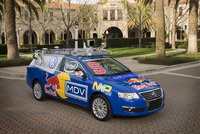Welcome, Junior: Stanford University, Volkswagen, and the DARPA Urban Challenge
By Carey Russ
The Auto Channel
I'm watching Junior practice his driving techniques in a parking lot near Shoreline Amphitheater, in Mountain View, California. He's being tested, and he's doing well. When he comes to a four-way stop sign, he stops - and waits for the car on the right to move, as required by the vehicle code. The next time he comes to the four-way stop, he's first, and realizes he has the right of way. He signals when he turns, and stays inside the marked road area. He follows cars at a safe distance and speed. When he comes up on a car parked in the road, he stops, then slowly pulls out to the left, sees that the lane is clear, and passes. He avoids other cars on the simulated road.
The only problem he has is on the first pass of the parked car, when a cone marking the correct path is placed incorrectly. Junior stops, in a quandary. He's apparently a little confused, like many a novice driver.
The difference is that Junior is not the driver. Junior is the car, a 2006 Volkswagen Passat TDI wagon specially modified with hardware and software developed by professors and graduate students at the Stanford University School of Engineering in nearby Palo Alto, California, and engineers from Volkswagen's Electronics Research Laboratory, also in Palo Alto. Further contributions come from Applanix, a manufacturer of geospatial guidance and positioning technology affiliated with Trimble, semiconductor maker NXP, the just-spun-off-from-Phillips maker of, among other things, automotive electronics and networks, microprocessor powerhouse Intel (involved here with both hardware in the form of Core2 Duo and Core2 Quad processors for Junior's "brain" and assistance in software development), and venture capital firm Mohn Davidow Ventures (MDV). Energy drink maker (and racing sponsor) Red Bull and Google (no introduction needed...) are also supplying sponsorship.
If this sounds like a cross behind a Silicon Valley start-up, cross-fertilized by academia, existing suppliers, and venture capital, and a racing team, that's because it is. The organization goes by the moniker "Stanford Racing Team", but it is not building a car for NASCAR, IRL, CCWS, or Formula One. And Junior is not being tested by the Department of Motor Vehicles. He's being tested by representatives from the Defense Advanced Research Projects Agency, DARPA. If he passes his driving test, he will go on to the semi-finals for the DARPA Urban Challenge, to be held at an as-yet-undisclosed location in California in November, 2007.
DARPA has deep roots in the valley, in both aerospace and electronics applications. Although it's the "blue sky" research and development arm of the Department of Defense, primarily involved with technologies with military application, DARPA-funded developments are not strangers to the civilian sector. If you're reading this on the Internet, thank DARPA. It, not any grandstanding politician, was behind the development of networks of computer networks in order for better communication between the military, defense contractors, and academics. ARPANET was the predecessor to today's Internet.
The Defense Department is interested in autonomous ground vehicles for obvious reasons - they can be used to bring supplies to soldiers in dangerous places. Or, robot tanks, anyone? Baghdad Taxi Service? Silicon Valley suppliers see a lucrative potential market, and Stanford students get experience developing cutting-edge technology. Volkswagen gets technology that can be used to improve safety. The laser rangefinders that function as Junior's eyes can detect hazards in the path of a human-driven car as well, and better accuracy in navigation systems is always welcome. And while a car that is autonomous all of the time would be rather boring, or an expensive replacement for a taxi, one that can function in that mode in an emergency or other instance of driver incapacitation, whether from medical condition or too much partying, could be a contribution to safety. "I'm sorry, Dave, you've had too much to drink. I'm taking you home now...."
And life being what it is and working as it does, there could well be plenty of unforeseen benefits.
The first DARPA Grand Challenge was held in 2004, and none of the entries finished. The second Grand Challenge was held in the Southern California desert in 2005, and won by Junior's "father" Stanley, a specially-modified VW Touareg, also under the auspices of the Stanford Racing Team.
So they are the defending champions, but the Urban Challenge will be much tougher than the previous desert race. Out in the desert, it was machine against nature, with only the need to stay on the mixed on-road/off-road course. The Urban Challenge will have interaction between multiple autonomous vehicles, human-driven vehicles, and perhaps pedestrians (a new use for undergrads?) in a simulated supply mission in a simulated urban environment. Where Stanley didn't have to be concerned with anything moving except perhaps desert wildlife, Junior will have competitors and other vehicles to deal with, a much more difficult, but much more realistic task.
Junior, named affectionately after Stanford founder Leland Stanford, Junior, with a nod to being the descendant of Stanley (named loosely after Stanford), was a credit to all and passed his tests with flying colors. The problem with the cone was traced to its mis-placement by a human. Junior will go to the semi-finals in October, and if successful there, to the final event on November 3, 2007. The event location will be announced on August 9, 2007, and spectators will be welcome.
For more information, see the DARPA website at:



